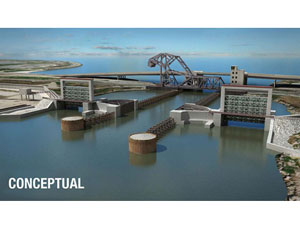Despite an early-contractor-involvement award protest by Granite Construction, Watsonville, Calif., the U.S. Army Corps of Engineers expects to start constructing an estimated $155-million storm-surge barrier on the Lake-Pontchartrain side of New Orleans this summer.

“We expect the ECI will be awarded in the next two to three weeks, and under a best-case scenario, we’ll start construction in July,” says Eric Stricklin, the Corps’ project manager.
The Seabrook Floodgate Complex will include a navigable sector gate and two vertical lift gates. It will block the northern end of the Inner Harbor Navigation Canal from storm surge on the lake. The complex will work in combination with a $1.3-billion barrier already being built to block surge from Lake Borgne, to the east. Together, they will provide critical protection for the eastern flank of New Orleans.
The public comment period on the environmental report closed at midnight on Jan. 27. If New Orleans District Corps Commander Col. Alvin Lee signs off on the report, the Corps will proceed with real estate acquisitions.
The $495,000 contract Granite challenged was awarded on Oct. 30 to Alberici Constructors, St. Louis. Ron Elmer, branch chief for the IHNC projects, says corrective actions have been taken in response to Granite’s complaints and the original bids will be reconsidered but not advertised again. He noted that with reconsideration, the award amount may change.
The ECI award is for preconstruction services to run concurrently with design work, allowing for collaboration between the Corps and its contractor in a quest for cost and time savings. The contract includes two subsequent options that would lead to construction and account for the bulk of the total estimated cost.
“The $155-million estimate is firm, based on that location,” says Richmond Kendrick, Hurricane Protection Office chief of program execution. “With ECI, we are buying a service contract for support, with an option to build.” But, he added, the arrangement means the specifics of design and location may change, and if they do, the estimate may change as well.
Elmer says the award protest will have “minimal effect” on schedule, which has been reshuffled because of requests for additional public comment periods, he says. There have been three public meetings since October and six on the project since the decision record was signed March 14, 2008.
The 25-month construction option originally was scheduled to begin this February. Now, with the start delayed until July, the schedule sets completion for August 2012, a year beyond the June 2011 deadline the Corps had pledged to meet for having 100-year protections in place for the whole city. But even without a finished project, Elmer says the Corps expects to have a cofferdam installed by June 2011 that will provide enough height to achieve the 100-year levels.
At a Dec. 3 public meeting, an extension for public comment was requested by the Port of New Orleans and by Henry Kenny, an attorney representing Seabrook Marina and Trinity Yachts, two businesses that are port tenants on the IHNC near the proposed project site. Kenny says the project will kill business for Trinity, which employs 300 people. He wanted to ensure the Corps considered all the proposed alternatives, specifically Alternative 5, which the Corps reports is the most beneficial for navigation.
“There is no decision” until the environmental report is signed, says Laura Lee Wilkinson, environmental manager with the Corps’ Hurricane Protection Office. Although Wilkinson conceded Alternative 5 is more appealing for navigation, its footprint would encroach on critical habitat. Kenny argued the Corps’ research for the environmental report dedicated about 40 pages to the “impact on fishes” and only “three or four paragraphs” to the economic impact on his clients. Kenny also is concerned about the duration of construction, which would result in closure of the canal, and future operation of the gates.
Clay Miller, director of business development for the Port of New Orleans, says he’s supportive of the Corps’ efforts to provide surge protection and thinks the Corps “is very concerned about the effects on our tenants both for economic impact to the region and the protection of the people.”



Post a comment to this article
Report Abusive Comment